"I've been noticing gravity since I was very young." -Cameron Diaz
Yesterday, I told you about one of the simplest arguments for dark matter. We look out at the fluctuations in the microwave background on all the different angular scales we can measure -- from about 0.2 degrees all the way up to the whole sky -- and look at what the temperature fluctuations are doing.
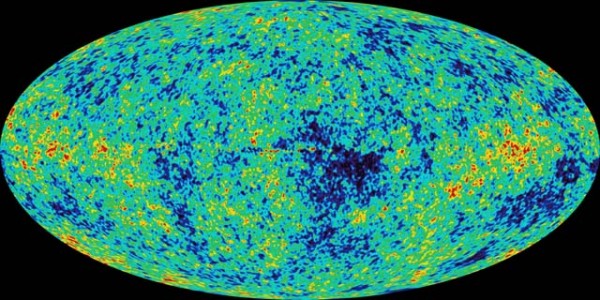
We also look at the large-scale structure in the Universe, and try to correlate how mass clumps together.

We are only allowed -- by the laws of physics -- a few parameters to play with to try to fit this massive data set. We know the Hubble constant, the average CMB temperature, and the amount of primordial Helium in the Universe (these are the three cornerstones of the Big Bang, and are well measured by other means), so the only things we're allowed to tweak is the "amount of stuff" in the Universe.
This stuff can be anything you can think of, and includes:
- normal matter (protons, neutrons, and electrons),
- photons (particles of light),
- neutrinos,
- dark matter (stuff that gravitationally works like matter, but doesn't interact with photons or itself),
- vacuum energy / cosmological constant,
- exotic forms of matter (cosmic strings, domain walls, etc.), and
- curvature.
This isn't an exhaustive list, but it may as well be. Remarkably, we can fit the data by tweaking these numbers, and we find that the Universe is made up of, more or less:
- 73% dark energy,
- 22% dark matter,
- 5% normal matter,
- 0.1% neutrinos,
- 0.01% photons,
- and a negligible amount of everything else.
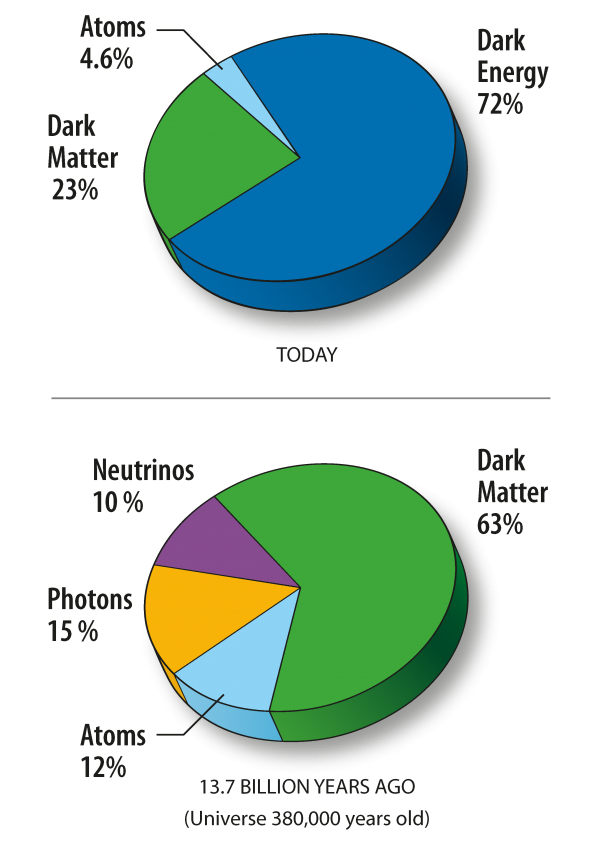
(It is worth pointing out that part of how we measure neutrinos and photons is that things were very different in the past.)
So if the Universe has about five times as much dark matter as normal matter, where is it? Since gravitation is always attractive, it stands to reason that if we want to find dark matter, our best bet is to look at where the normal matter is. Moreover, we'd better look at where the most normal matter is.
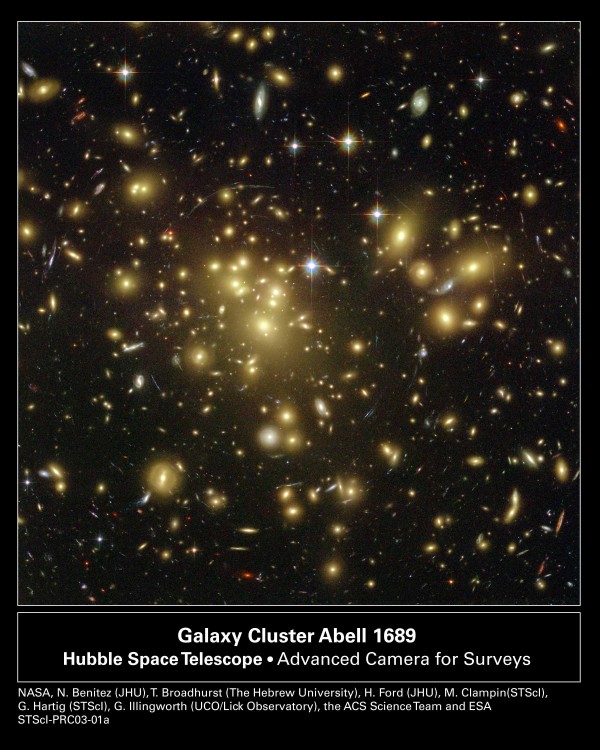
And so your first guess would be to look at galaxy clusters; that's where I'd look, too. (This one, above, is cluster Abell 1689.) Not surprisingly, observations of galaxy clusters were actually our first piece of evidence for dark matter, all the way back in 1933!
Now, we want to make sure we know where all the normal matter is, not just the stuff that our eyes catch. So we look in the infrared, and make sure we're getting all of the cool gas and dust that gets heated only by reflected and absorbed starlight.
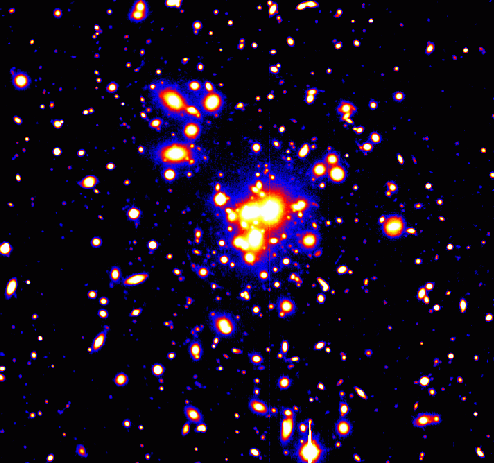
And although this image is rotated with respect to the other one, it's pretty clear that they align very well.
What about very hot gas? That would be stuff that emits X-rays. Let's take a look...

Well, the X-rays come from all over, but they're centered on the largest, most massive galaxy, as well as a few other point sources.
Now, the big question is this: does gravity come exclusively from the places where this normal matter lives, or is there another source of gravity?
Well, let's go over how we can figure this out.
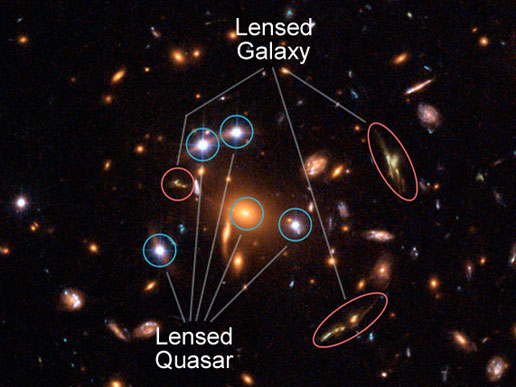
One of the consequences of gravity is the phenomenon you see in the image above: gravitational lensing. When there's a large amount of mass between us (the observer) and the object we're looking at, that mass acts like a lens, distorting and bending the light coming from the image.
Here's the important part: the way the light bends depends only on the total mass and its configuration. Unlike the other images I've shown you, it doesn't care what the temperature is, and it doesn't even care whether this is normal matter or dark matter. To a gravitational lens, mass is mass, period.
So take a closer look at Abell 1689. What's going on deep inside that image?

Arcs, bent light paths, multiple images, distortions... oh my, this cluster is possibly the best one we've ever found in terms of the richness of lensing available.
It was only a matter of time before someone took advantage of this. The most detailed dark matter map of a galaxy cluster ever made -- thanks to Dan Coe at JPL and his collaborators -- is available right here.

As you can see, the dark matter often lines up with the normal matter, but not exclusively! And this is what we'd expect, because although they both experience the gravitational force, normal matter experiences collisions with other normal matter and with photons, but dark matter doesn't.
Different forces means that, in a chaotic environment, dark matter and normal matter are likely to arrive in different locations. It's only over the last few years that we've been able to differentiate where the dark matter is from the normal matter. And while it's not as spectacular as it is in the Bullet Cluster,

It's maybe even more important here. Because this isn't some fantastic, rare collision of galaxy clusters happening here; this is just a run-of-the-mill galaxy cluster going about its daily affairs. And yet, dark matter distinguishes itself from the normal matter even in this cluster!
Yes, to those of you who are skeptical, I can't prove that dark matter exists without discovering the particle responsible for it. But when I look at the entire suite of evidence, the evidence for the existence of dark matter is overwhelming. There's still plenty we don't understand and that we need to learn, but to go without any dark matter of any type? You have to throw out the entire Universe for that, and it just makes too much sense and works too well for me to do that without some really compelling refutation. (In my humble opinion.)
But this new data? It's just more compelling evidence in favor of dark matter. And, if I do say so myself, an awfully pretty picture...

What is the N and the E representing in the 2nd to last photo?
If you want to see a vocal doubter of DM and a prominent defender of it battle it out on stage, come to Bonn University today (Thursday)!
Hey crd2, I'm not sure what N and E are designating, if it's not Right ascension and Declination. Could be Galactic North and Equatorial in a Galactic coordinate system.
Abell 1689
Hey crd2, Tried to send a link...it got caught in filter so copy/paste this:
en.wikipedia.org/wiki/Abell_1689
Then go to upper right of wiki and click on the actual Right ascention and Declination coordinates.
The N and E may be galactic coordinate system (GCS).
North and equatorial...not sure.
Whoops, should have been more accurate Galactic North and Equatorial pole. See Wiki galactic coordinate system for full description.
I was just thinking maybe someday we will have a larger library of dark matter projected photos.
Question on the pie charts,
the past chart indicates no dark energy, while the present chart is 72%
I'm going to assume the accepted science is, (contrary to what I suspect) The amount of of dark matter and normal matter has not changed though the percentage has, due to expansion and dark energy creation.
Would that be a correct assumption?
Would the dark stuff be a particle which is not expected to be part of the current standard (particle) model, or is it expected to be composed of the usual bosons leptons and quarks?
You keep making the distinction between normal matter and dark matter. There are plenty of condensed matter objects, some compact, that are dark by the definition of being less luminous than predicted by the stars' usual range. Can you give me a reason why I should believe the microlensing exclusion of MACHOs as the bulk of dark matter (really, tracking the luminosity of objects for short periods of time and looking for spikes does not inspire confidence)?
If dark matter is subject to gravitation but does not interact with itself or matter then why does it not collapse into one per galaxy giant black hole?
Ethan: "We are only allowed -- by the laws of physics -- a few parameters to play with to try to fit this massive data set. We know the Hubble constant, the average CMB temperature, and the amount of primordial Helium in the Universe (these are the three cornerstones of the Big Bang, and are well measured by other means), so the only things we're allowed to tweak is the "amount of stuff" in the Universe."
This is a contradiction, the "amount of stuff" we tweak itself consists of *infinitely* many parameters. And dark matter density is particularly problematic since it is present in every point in spacetime (infinitely many parameters) and is pretty much unconstrained by anything other then the extra curvature it was invented to explain.
"Dark matter" should really be called "unexplained/unaccounted for spacetime curvature" then I would have no problem with it.
Confused: "If dark matter is subject to gravitation but does not interact with itself or matter then why does it not collapse into one per galaxy giant black hole?"
For the same reason Earth doesn't fall onto the Sun.
Gravity alone is not enough for collapse, the gravitational potential energy of the objects has to be transferred away by some other means for the collapse to take place.
Usually electromagnetic interactions play this role - for example a dust cloud may heat up due to collisions of it's particles and the resulting heat is radiated away as EM radiation allowing the collapse to proceed.
Al: "For the same reason Earth doesn't fall onto the Sun.
Gravity alone is not enough for collapse, the gravitational potential energy of the objects has to be transferred away by some other means for the collapse to take place.
Usually electromagnetic interactions play this role - for example a dust cloud may heat up due to collisions of it's particles and the resulting heat is radiated away as EM radiation allowing the collapse to proceed."
The first analogy I understand, there is no reason for it not to stay in orbit. The dust cloud example makes sense for matter that physically interacts with other matter, but if dark matter does not interact with other matter then why is there any requirement for it to release energy in order to converge on a single location via gravity?
I apologise in advance if I am missing something obvious here.
This is a contradiction, the "amount of stuff" we tweak itself consists of *infinitely* many parameters. And dark matter density is particularly problematic since it is present in every point in spacetime (infinitely many parameters) and is pretty much unconstrained by anything other then the extra curvature it was invented to explain.
@AI:
Methinks you don't know what "parameter" actually means.
Dark Matter was not invented to explain the "extra curvature" - it was invented to explain the rotation curves of galaxies and the motions of galaxies in galaxy clusters. That it also explain the "extra curvature" (and lots of other things in cosmology, see Ethan's last post about the "Simplest argument") is a nice confirmation that this stuff really exists. Additionally, the properties of Dark Matter are constrained by the observations - for example, we know that it has to be cold (move with non-relativistic speeds) and collisionless.
Confused: "but if dark matter does not interact with other matter then why is there any requirement for it to release energy in order to converge on a single location via gravity?"
Imagine two particles of dark matter interacting only gravitationally and initially separated by some distance. They have gravitational potential energy. Due to gravity those particles will be accelerating toward each other and so by the time they are in the same place they will have high velocities (their potential energy has now been converted to kinetic energy) and so they won't stay close but will instead speed past each other. Gravity will still act on them pulling them together so once they pass each other they will keep slowing down end eventually stop (all kinetic energy at this point is converted back to gravitational potential energy). And now we are back to square one and the cycle will repeat.
The above is the special case when the particles have no initial velocity in some other directions, in most cases they will have such velocities so they will follow Keplerian elliptical orbits around their center of mass.
See animations here
http://en.wikipedia.org/wiki/Gravitational_two-body_problem
Now a hypothetical dark matter cloud would have countless such particles interacting gravitationally and following very elaborate paths but they could not collapse unless they could somehow transfer their excess energy out of the cloud.
@Thorny: E. g. primordial nucleosynthesis and the CMBR power spectrum give us pretty near constraints on the amount of "normal" (i. e. baryonic) matter in the universe, including such "dark" condensed matter objects you mention. And the conclusion is that there is not enough "normal" matter, i. e. the rest has to be non-baryonic.
Bjoern not only you don't seem to get what a parameter means - every value in your model you can freely adjust to fit the data is a parameter - but you also don't understand what curvature means in the context of GR - "rotation curves of galaxies and the motions of galaxies in galaxy clusters" are nothing else then manifestations of spacetime curvature.
In other words both your objections are absurd.
Very nice explanation Ethan. But let me quibble only a bit.
Quibble first, well the laws of physics and especially the cornerstones of the big bang model may need to be significantly modified. That said..
Dan Coe's dark matter map is excellent work. It constrains any candidate "dark matter" theory; and challenges the big bang model regarding cluster formation.
Your explanation, "normal matter experiences collisions with other normal matter and with photons, but dark matter doesn't" is crisp, reasoned and important.
Yes it begs the question: Why doesn't dark matter collide? Well we don't know yet; even wringing possible answers from your exhaustive candidate list.
So no skepticism from me today. You've provided both enough new information and a list of possible candidates to satisfy this skeptic. Thank you.
@AI:
Good, so you do know what a parameter is. In the meantime, I've seen in the comments of another article where your error is: you claim that one can choose the local density of Dark Matter and Dark Energy as one likes. If that were true, you'd be right - there would be infinitely many parameters. But unfortunately for you, that simply isn't true.
You are right, one can see it that way - I misunderstood you and thought you talk only about the curvature of the universe as a whole. But then I still don't understand your objection: there are three totally different types of "extra curvature" (on a galactic scale, on the scale of galaxy clusters and on the scale of the universe as a whole) which Dark Matter all explains essentially with one single number (the mean density). Additionally, there are such pieces of evidence as the ones which Ethan discusses in the article "The simplest argument...".
Additionally, "extra curvature" implies (if General Relativity is true) that there has to be extra energy, and from the properties of that extra energy (e. g. density distribtutions inferred from the data), it is quite clear that this extra energy is in the form of the (rest) mass of particles. So why on Earth do you object to calling that stuff Dark Matter?!?
I think that "does dark matter collide with itself?" is the same question as "does dark matter take up space?" In the blog entry "Why does Matter take up Space?" our host explains the Pauli Exclusion Principle and that certain classes of particles are subject to it while others are not.
DM has mass which means it travels at some speed less than light. It does not have electric charge and it may not carry the strong nuclear force, for in the absence of electric charge, that would take over and make it clump. Does it spin?
And as I'm a software engineer and only layman when it comes to advanced physics, I'll stop now while the stopping is good.
"The end of physics." Hah.
Bjoern, I think part of why people are uncomfortable with dark matter is that it's limiting us to one explanation only. We observe gravity effects, as Ethan has again shown very well, we can't think of a way to get gravity without mass, so there has to be invisible matter. It's like the 19th century Aether model, we can't have forces transmitted without something transmitting it, so we have something invisible doing it. Maxwell came up with his equations despite being convinced of the existence of Aether, so you can still be correctly describing the phenomenon without being right about the cause thereof.
To me, we know GR fails when it comes to QM dimensions, and QM fails at gravity, and neither has an explanation for what a WIMP could be made off. Until we fill that gap, dark matter and dark energy are just a poor and very limiting description for "something distorting space time on the largest scales that we don't understand"
@Mu:
Well, I'm open to the possibility (and I'd say that a lot of physicist are open to that, too) that we may need both Dark Matter and a modification of gravity in order to explain all observations - so obviously Dark Matter does not limit one to "one explanation only".
Err, yes, we can - and we have thought of that for about 90 years now. Hint: According to General Relativity, not mass is the ultimate source of gravity, but energy, momentum and pressure are.
But that Aether concept was internally contradictory (in order to explain some observations, it had to be dense, in order to explain others, it had to be dilute, etc.), whereas most observations we have today which point to the existence of Dark Matter are consistent among each other.
It's right that one describe a lot of electrodynamic phenomena correctly by using the Aether concept - but not all: the constancy of the speed of light in all frames of reference contradicts the Aether hypothesis.
Err, ever heard of axions? Of neutralinos? Of sterile neutrinos?
Real quick;
I just wanted to add MSSM (Minimal Supersymmetric Standard Model) and supersymmetry to Bjoern's list of "What a WIMP could be made"
Comment#5 Thorny;
MACHO's have somewhat fallen out of favor due to the BB model as we know in it's best form can not have produced the magnitude of baryons/(fermions)needed,also baryons are subject to the strong nuclear force though not all fermions are subject.Baryons are strongly interacting fermions.
Dark matter is weakly interacting, Hence Dark matter is thought to be Weakly Interacting Massive Particles=WIMPs.
Comment #6 Confused;
I do think that dark matter does interact with itself, just not in any major analysis, a minor action, more like in a edge effect or a thin event horizon where the configuration breaks down, so self-interaction would not be a major player, it may explain the DAMA signal. So does not self-interact (for the most part)would be correct. It is indeed a puzzle.
Comment#12 Al;
Exactly! And as a particle configuration that for the most part does not couple or interact, it is always in a state of acceleration and therefore induces a fictitious force to lower states of matter.That is one aspect of a possible link between dark and normal matter(still working on that)
What is the proceedure for finding the DM distribution, ie:, why can't the hazy blue be replaced with (small) clumps? True, the dark matter would not clump, but how do we calculate the 'smeared' distribution?
Neil
Comment #22 Neil;
I'm not sure there is a best answer.
Einasto profile
and/or other
Ethan?
I've got a comment with 2 links waiting in system buffer, if retrievable, until then I would briefly ans. Comment 22 with (Einasto profile).Thats my best ans. If I understand the question correctly.
@Sphere Coupler, #23:
I was unaware that the Big Bang models are accurate enough to predict the total amount of baryons, say (not much baryogenesis happening after that on a large scale), generated in it to within an order of magnitude. This sounds fishy when combined with "oh, and there are some WIMPs that were also generated, but this doesn't affect our estimates".
A parameter is a "fixed variable" which would at first seem to be an oxymoron but that's how science works.
As to one variable part: Taken from http://en.wikipedia.org/wiki/Vacuum_energy
"Using the upper limit of the cosmological constant, the vacuum energy in a cubic centimeter of free space has been estimated to be (10 to the minus 15) Joules.[1] However, in both Quantum Electrodynamics (QED) and Stochastic Electrodynamics (SED), consistency with the principle of Lorentz invariance and with the magnitude of the Planck Constant requires it to have a much larger value of (ten to the one hundred and seven) Joules per cubic centimeter." (Value notations edited due to superscript.)
This represents a massive spread between the cosmological constant or constants value(s) currently in use (I am assuming there is a lower limit as well as the above mentioned higher limit) and what I could term the "reality" value of our universe's vacuum energy situation as provided by some carefully derived physics/electrodynamics numbers as given by the cited wiki article. Perhaps this does much to explain the truly astronomical magnitude of the problems we are dealing with. Could it even be that the assumed cosmological constant was derived from observations which are (even more than we suspect) massively distorted?
The gravitational lensing pictures (to our great delight) show how various forces can duplicate objects by generating multiple path distortions, but what is more difficult to determine is how such powerful interferences (or simply very persistent weaker ones) must also manipulate distant images in a negative manner. I suspect that the net statistical result of what we can actually manage to observe of the cosmos electromagnetically from our very limited point of view is that negative factors just naturally greatly dominate things. Chaos rules!
Thorny;
Well of course it's going to sound somewhat fishy, collectively we don't know what a WIMP construction will end up being, and you are correct to remain skeptical, scientist have to work with best known theories and data to further understanding.
At present BB nucleosynthesis along with WMAP and a great deal of other observations, rival and has had the greatest impact on progressing theory, The key parameter which allows one to calculate the effects of BBN is the number of photons per baryon.
I too remain skeptical, (a healthy skepticism I hope) to relying on any one function too tightly, knowing the major factors leads one on a fluctuating journey, it still fits within the parameters of the main theory. The Universe is a big place and not all is known.
Someday we may discover something that blows all our knowledge base out of the water,I'm an optimist yet even I wouldn't bet on that scenario.
Ethan Siegel has a link to the Starts with a bang archives at the top of this page...click on Big Bang and peruse the 42 (as of today) Post. They are a good guide line and have helped me learn or relearn in a meaningful context.
Ethan reports the science that we can best rely on,(being a theoretical scientist it takes discipline to remain relevant)
Also this wiki tends to remain non-speculative and neutral.
Abundance of primordial elements
Normally, I would have injected some speculative thoughts into this discussion...my spare time seems to have diminished of late!
One thing I forgot to say is;
In science communication it is imperative to use the correct wording,(especially when refering to a prior comment)so as to not be misunderstood...I myself have fallen upon that knife.
Magnitude;
greatness of size, volume, or extent:
computing the magnitude of heavenly bodies
Versus
Order of magnitude;
size range: the difference in size, usually expressed in powers of 10, between two quantities. For example, a quantity 100 times greater than another would be two orders of magnitude greater
Versus
Order of magnitude;
size range: the difference in size, usually expressed in powers of 10, between two quantities. For example
islam kelimelerinde en iyi yerlere gelmek istiyoruz